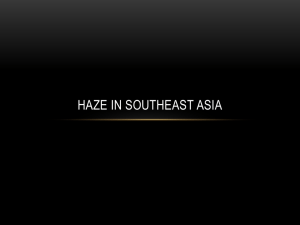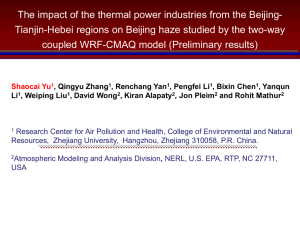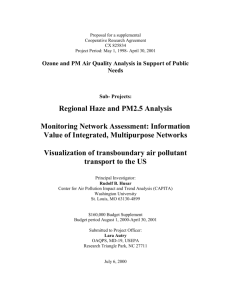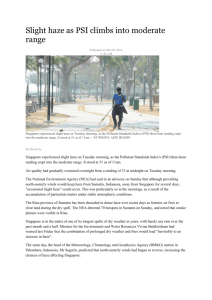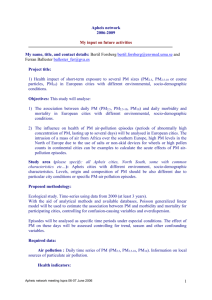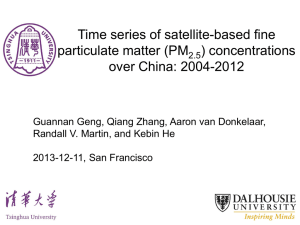Visualization of Transboundary Air Pollutant Transport to
advertisement
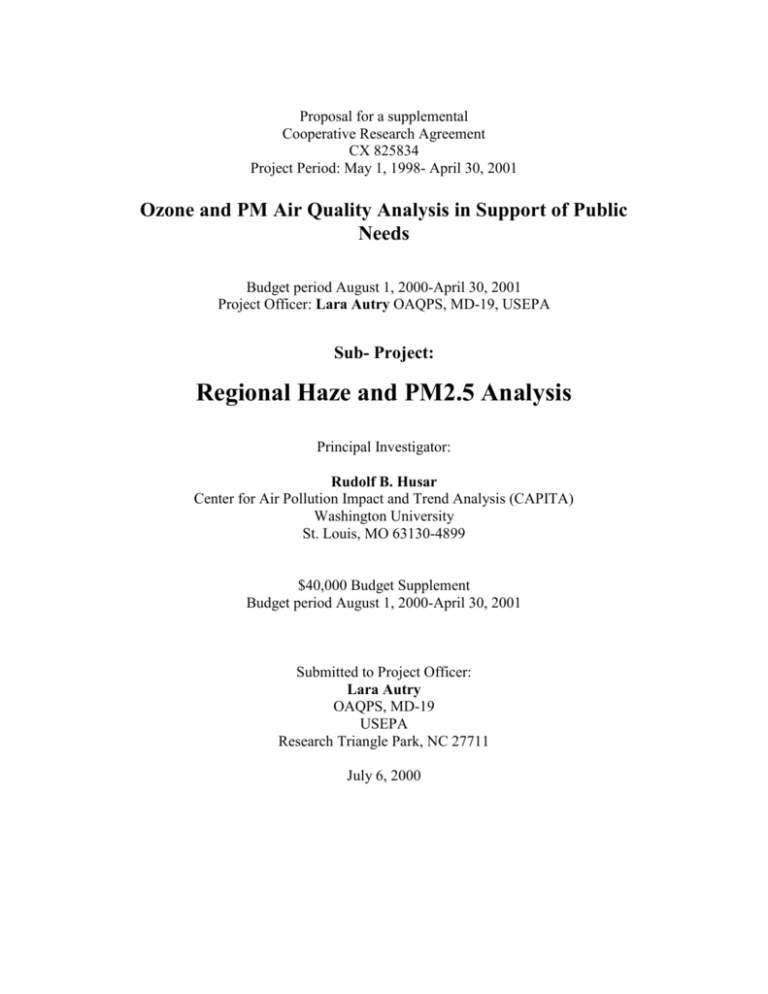
Proposal for a supplemental Cooperative Research Agreement CX 825834 Project Period: May 1, 1998- April 30, 2001 Ozone and PM Air Quality Analysis in Support of Public Needs Budget period August 1, 2000-April 30, 2001 Project Officer: Lara Autry OAQPS, MD-19, USEPA Sub- Project: Regional Haze and PM2.5 Analysis Principal Investigator: Rudolf B. Husar Center for Air Pollution Impact and Trend Analysis (CAPITA) Washington University St. Louis, MO 63130-4899 $40,000 Budget Supplement Budget period August 1, 2000-April 30, 2001 Submitted to Project Officer: Lara Autry OAQPS, MD-19 USEPA Research Triangle Park, NC 27711 July 6, 2000 Regional Haze and PM2.5 Analysis Background This is a brief proposal to EPA OAQPS as part of the Cooperative Agreement CX 825834 "Ozone and PM Air Quality Analysis in Support of Public Needs" between EPA and CAPITA. The new haze regulations will require the states to estimate the level of haze based upon the chemical composition of the dry ambient aerosol. The states as well as the general public needs to better understand the causal mechanism for haze as well as the relationship between the measured PM2.5concentrations and the haze regulations. The purpose of the proposed analysis is to provide background information on haze including the PM2.5-haze relationship. The information will be presented in such a way that it can aid all the main stakeholders involved including federal, state and local agencies as well as the interested public. In addition, the first year of the FRM PM2.5 data, collected by the National fine particle monitoring network, is due to be delivered by the States to AIRS by March 31, 2000. CAPITA will cooperate with OAQPS in obtaining and exploring these data, followed by initial analysis of these data. The specific goals of the this sub-project has three parts: 1) Write a chapter on haze for the PM Analysis Workbook. 2) Explore the first year of FRM PM2.5 data examining the content of the database, its quality and generating overall statistics. Haze Chapter for the PM Analysis Workbook The new haze regulations require states to establish baseline haze levels and the natural conditions, i.e. haze levels that would exist without anthropogenic contributions, for all Class I areas. In addition, all states will need to access their contributions to haze in Class I areas and provide State Implementation Plans to remove their contributions to the anthropogenic haze in the Class I areas. The PMfine workbook haze chapter will contain three sections to aid states in complying with the new haze rules. 1) Background information on the physical mechanism responsible for haze. Many states are unfamiliar with the causal factor of haze. Therefore, a section that provides background information on haze from the nature of light to its interaction with ambient particles will be provided. There are a number of excellent sources of information on the causes of haze such as the 1978 Visibility Report to Congress, the NAPAP report Volume 24 and the more recent publication "Introduction to Visibility" by William Malm that will be drawn upon for this section. 2) Relationship between haze and PM2.5. The new haze regulations require haze levels to be estimated from measured aerosol samples. This section of the workbook will describe the relationship between haze and PM2.5, as well as established technique for reconstructing haze from the measured aerosol samples. 2 3) Fine mass and haze patterns and trends. National and seasonal patterns of the PM2.5 mass, its constituents and the haze levels reconstructed from the aerosol data will be presented. In addition National haze maps derived from visibility airport concentrations and their long-term trends, i.e. from 1940-95, will be presented. Last, estimates of the natural background levels as report in the NAPAP report will be provided. Exploration of FRM PM2.5 Data - Year 1 The national PM2.5 network has been in operation since January 1999 and the first year of data will be available from AIRS for analysis in early April. CAPITA will cooperate with OAQPS in the initial analysis of these data in four ways: 1) Enhancing the data availability. The FRM PM2.5 data will be available from the EPA AIRS database. Experience has shown that there are a number of resistances to accessing AIRS data which are difficult for most people to overcome. Therefore, CAPITA will obtain all FRM PM2.5 data from AIRS, and reformat it into ASCII and Voyager files. These resulting data files will be made available via the PMfine workbook website. 2) FRM PM2.5 monitoring sites and data collection statistics. The overall distribution of the data will be documented. This will include maps of the location of the monitoring sites, the monitoring sites starting dates and the monitoring sites collection statistics. 3) Quality assurance and control of the database. Initial quality assurance and control will be conducted by examining the data for each site for spatial and temporal consistency. This cursory examination will be designed to identify outlying data points. 4) PM2.5 data analysis. Simple statistical analyses examining overall spatial and temporal patterns of the data will be conducted. These analyses will include examination of PM2.5 seasonal maps as well regional statistics including, mean, standard deviation, and the upper and lower percentiles. The initial exploration of the database will be completed by the end of May, in time for EPA's initial FRM PM2.5 data report. More detailed data analysis of the data will continue after May. The exact analyses to be conducted will be guided by the results of the initial analysis and feedback from interaction with the data users. Schedule The work will be conducted during August, 2000 – April, 2001. Intermediate outputs will be discussed with the Project Officer, Lara Autry. Budget The budget for the project is $40,000. The detailed budget is listed in the attachment. The project will be conducted through incremental funding to the Cooperative Agreement CX 825834 between EPA and CAPITA “Ozone and PM Air Quality Analysis in Support of Public Needs” 3 Personnel The project will be conducted by Professor Rudolf B. Husar, director of the Center for Air Pollution Impact and Trend Analysis. One or two graduate students will participate in the project. Drs. Stefan Falke and Bret Schichtel will serve as consultants to the project. 4 PROJECT TITLE: OZONE AND PM AIR QUALITY ANALYSIS IN SUPPORT OF PUBLIC NEEDS PROJECT PERIOD: 05/01/1998 - 04/30/2001 EPA ASSISTANCE ID NO. CX 825834-01-2 PRINCIPAL INVESTIGATOR: RUDOLF HUSAR SUPPLEMENTAL FUNDING REQUEST Regional Haze and PM2.5 Analysis BUDGET PERIOD: 08/01/2000- 04/30/2001 Salaries Rudolf B. Husar, PI Graduate Research Assistant Undergraduate Lab Asst. EPA WU TOTAL 13,813 3,000 550 1,145 14,957 3,000 550 17,363 1,145 18,507 2,730 127 2,857 20,092 1,272 21,364 600 0 600 1,375 0 1,375 668 0 668 3,600 0 3,600 Total Direct Costs 26,335 1,272 27,607 Total Indirect Cost Base @56.0% Total Indirect Cost Base @ 54.5% Indirect Cost @56.0% MTDC, current Indirect Cost @54.5% MTDC, effective 7/1/00 Total Indirect Costs 4,160 20,800 2,330 11,336 229 1,142 128 623 4,389 21,942 2,458 11,958 Total Direct and Indirect Costs 40,000 2,022 42,022 Total Salaries Fringe Benefits Total Salaries and Fringe Benefits Travel 1 person trip to a technical meeting partial charge Equipment 1 pentium grade computer and peripheral equipment partial charge Other Expenses Software library charges Telephone long distance / fax charges Computer network charges Publication charges Consulting Bret A. Schichtel Bryan Van Hook Stefan Falke 5

